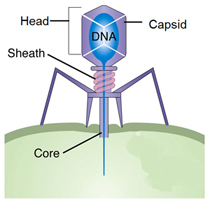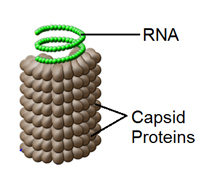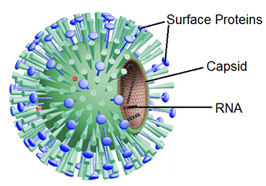
Have you ever had the flu? A cold? Chicken Pox? If you have you have had a virus. A virus is a nonliving particle made of proteins, nucleic acids, and sometimes lipids. Viruses are not-living because they do not have the ability to reproduce on their own. They must be inside a host cell in order to reproduce. Viruses differ widely in terms of size and structure, as you can see in the diagrams below. Most viruses are so small they can be seen only with the aid of a powerful electron microscope.
Look at the images below. What structures do you notice common to the viruses shown?
Interactive popup. Assistance may be required.
All the viruses pictured contain genetic material and a capsid.



All the viruses shown have some type of genetic material, either DNA or RNA. All the viruses pictured above also have a capsid, or protein coat surrounding the virus. The capsid has three functions:
![]()
Directions: Below is a picture of the virus. Label the virus by dragging the names to the appropriate structure.
Sources for the images used in this section as they appear, right to left and top to bottom:
Bacteriaphage, Texas A&M University
Tobacco virus, Brooklyn College
Flu virus, Lenny Stoute, Digital Journal
Virus, Molecular Expressions